Keeping Your German Shepherd Healthy: 9 Exercise Routines
If you have a German Shepherd, then you should already know how high-energy this breed of dog is, and how much energy it has.
If you’re planning on getting a German Shepherd this is your warning, they need a full-on exercise routine in order to have their needs properly met!
And the thing is, walking your German Shepherd every day isn’t enough.
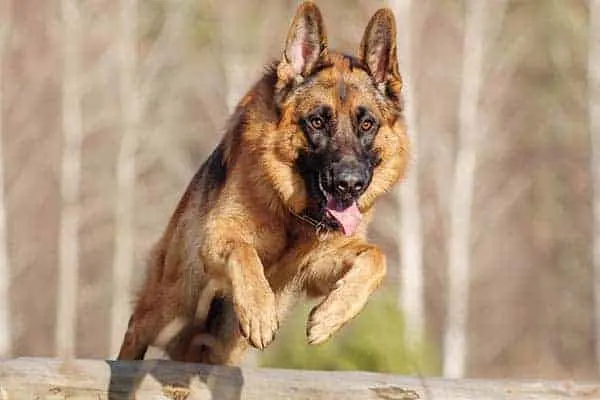
Sure, walking your dog is great, but it can get a bit repetitive, and simply walking will not fully cover the health needs of your German Shepherd.
In order to be as healthy as possible, your German Shepherd needs a variety of different exercise routines, which combined, will cover all the different exercise needs!
Multiple different exercises will not only keep your dog healthy, and ensure that your dog is nice and relaxed at home, it will also improve behavior in general and stimulate your dog mentally.
There are plenty of different exercise routines and activities that you can design for your German Shepherd.
But if you’re looking for a few highly effective ones to begin with, then here are our top 9 recommended exercise routines for any German Shepherd dog!
1. Daily Walks
Walking your dog is pretty much the dog-owner standard of making sure your dog moves every day, and ensuring it gets a bit of fresh air and exercise.
But how often should you walk your dog? And for how long?
A smaller breed of dog might be fine with just a quick walk around the block, but German Shepherds are big and high-energy, not to mention that they are working dogs.
So essentially, they need a little more than just a small walk.
As a general rule, you should walk your German Shepherd at least twice a day, and if your German Shepherd is young and healthy, aim for three times a day.
(You might also have to add toilet breaks if your dog can’t relieve itself at home!)
You should also aim to vary the surface that you are walking on, and avoid always walking on concrete. Look for grass or dirt paths, as they will be a lot softer on your dog’s joints and hips.
Walking through parks or nature trails is always a plus, as it will give your dog a lot more to explore and sniff around for too!
A walk isn’t just about getting your German Shepherd to move, it’s also an opportunity to explore and interact with the outside world, for mental stimulation.
Exercise Routine:
For an adult and healthy German Shepherd, two one-hour walks a day is a good standard. For a puppy German Shepherd, do not walk them for more than 5 minutes for every month that they are old.
Make sure to take it slow and let them set the pace.
Recommended Amounts of Daily Exercise For German Shepherd Puppies
| Puppy Age | Daily Exercise |
|---|---|
| 3 Months Old | 15 - 30 minutes |
| 4 Months Old | 20 - 40 minutes |
| 5 Months Old | 25 - 45 minutes |
| 6 Months Old | 30 - 60 minutes |
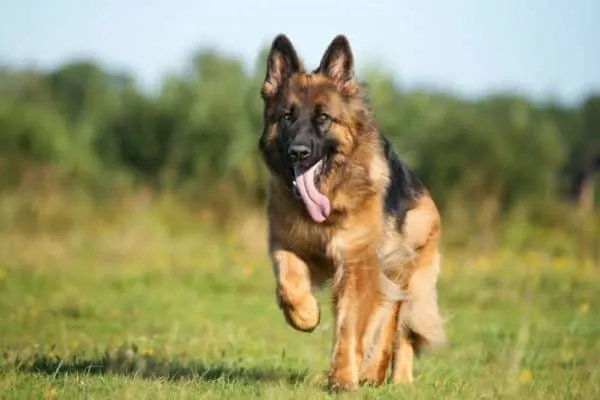
2. Doggy Squats
Do you know how humans do squats as a pretty standard exercise within fitness routines? Well, dogs have their very own version of squats that they can do too!
It might seem like a bit of a weird exercise for your German Shepherd, but it will keep your dog’s hips healthy, as well as build strength in the leg muscles.
German Shepherds are at a very high risk of developing hip problems as they grow older, so this is a very good exercise to have them practice every now and then.
The squats can also be a very mentally stimulating exercise for your German Shepherd, and you should include treats in order to ensure they are done correctly and your dog follows your precise instructions.
And to prevent your German Shepherd from eventually getting bored and losing interest, you can switch up the location of where you practice the squats, choosing different surfaces and using different treats.
But how do you get your dog to squat? Easy, just follow these steps:
- Have your dog sit, following the sit command you have in place.
- Then, command your dog to stand.
- Do this a few times, so that your dog is performing a repetitive motion of sitting and standing, sitting and standing. This is their version of the squat.
- Use treats to reward each squat so that your dog is engaged and eager to follow the instructions.
- Start with reps of 5 squats, and increase the number of sets as your dog progresses over time. (Be careful not to overdo it!)
Puppies and older German Shepherds shouldn’t really do this exercise, but it depends on each individual dog.
Exercise Routine:
Do a few sets of squats two or three times a week. However, if you suspect that your dog might have any hip issues, do not perform any squats, as this could make the issues worse.
3. Playing with a Balancing Disk
Balancing disks are really popular amongst dog exercise gear, and the great thing about them is that they can be used right at home, without the need for much space, making them pretty convenient!
The balancing disk is great for improving reflexes, which in turn can prevent any clumsy falls for your dog. It also enhances body awareness, making your dog more in control overall of every movement.
So your dog will be more agile, less prone to injuries, and will have better muscle reflexes.
To use it, your dog essentially has to balance on the disk, by standing on top of it and staying as stable as possible. There are also various challenges you can add to the exercise, such as:
- Have your dog stand on the balancing disk, then give your dog gentle shoves and pushes, moving them, so that they have to readjust their body and position.
- Move the balancing disk while your dog is on it, so that balance becomes harder.
- Increase the difficulty of the exercise by giving your dog less harness support, or getting a smaller disk.
Make sure you have plenty of treats to encourage your dog to perform well!
The exercise can also help you bond with your German Shepherd, and it can be a very mentally stimulating activity that your dog will likely grow to love!
Exercise Routine:
Perform this exercise with your dog around three to four times a week. Start with the easiest levels, and slowly increase the challenge over time.

4. Playing with a Flirt Pole
A flirt pole is essentially like a giant cat toy. It’s a pole, with a string attached to one end, and an enticing lure at the end of that string that your dog will want to chase.
This item is absolutely perfect for German Shepherd owners that are a little tired out, as it allows you to exercise your dog without you having to move much!
This can be turned into a really fun game to keep your dog entertained, but it also helps increase endurance and focus.
Plus, if done well, it also teaches your German Shepherd to handle impulse control and to listen to basic commands when hyped up.
To use the flirt pole, follow these steps:
- Tempt your dog into playing with the flirt pole, by dragging it across the floor in front of them and making the lure at the end move in circular patterns.
- Move the toy in different directions and at different speeds, while your dog chases it.
- Once your dog catches the lure, play a bit of tug.
- Give your dog the command to drop the lure, reward, then start all over again.
You could be sitting on the sofa throughout this whole game, and meanwhile, your dog will be expending a lot of energy and having a lot of fun.
It’s perfect! Just avoid this exercise with puppies, as they aren’t coordinated or strong enough for it just yet.
Exercise Routine:
Practice this exercise two to three times a week. Make sure you are on a soft surface such as carpet or grass, in order to avoid any injury.
5. Playing with a Spring Pole
A spring pole is an excellent item to have, as it allows your German Shepherd to play with themselves, tugging and pulling and overall using up a lot of energy.
And meanwhile, you can just watch and chill! You could even have it set up in your garden!
Essentially, it’s a pole that goes into the ground and that is highly flexible, with a rope on one end that will have some sort of lure.
The dog can catch the lure and tug at it, and the pole will bend and move about but will stay stuck to the ground, so your dog will never quite win but keep on trying until fully tired.
These are also made to attach directly to trees, which are often even easier options.
This exercise enhances the power and strength of your German Shepherd, and it covers their athletic needs, as well as being a mentally stimulating game for them.
It will help develop your dog’s muscle mass and will keep them energetic and active. Plus, it will tire them up so that they’re calmer and more focused when it comes to other activities.
Exercise Routine:
Set up the spring pole for your dog two to three times a week, and make sure it’s on a surface with good traction, so that your dog is able to pull without slipping or falling. (Grass is ideal).
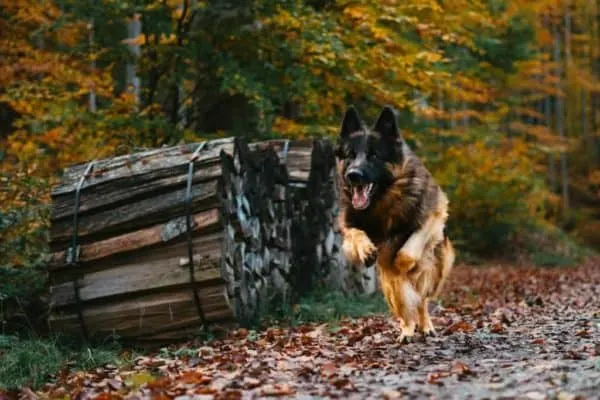
6. Running
The best way to make sure that you and your dog both get that cardio in is a good jog. German Shepherds are incredibly athletic and therefore are built for running.
They also especially love running with their owners, as it’s not only good exercise but also a fun bonding time.
The best way to do this is over various different surfaces so that your dog gets a break from concrete floors, which can be hard on the joints.
You should also combine different paces so that running does not become repetitive or boring. Have some slow running and then some intermittent sprinting now and then!
However, don’t avoid running on concrete or asphalt entirely, as it provides a few useful benefits!
It can help keep your dog’s nails naturally short and filed, it strengthens the larger muscles, it increases strength in bones, tendons, and ligaments, and it will slowly harden the pads of their feet so that they are better protected against possible cuts and abrasions.
So…yeah. Running is a great exercise and your dog will love it. Just avoid doing this with puppies, as they need to have fully fused bones before they can do this safely.
Exercise Routine:
Go for a run with your adult and healthy German Shepherd around three to four times a week. Allow for plenty of rest afterward, to avoid overworking your dog.
7. Running Uphill
Running uphill is harder than running on an even surface or even downhill, so it makes sense that this would be a more intense exercise that provides different benefits to simply running.
When your German Shepherd runs uphill, they are getting bonus strength training, as they will be engaging their rear legs and muscles in a far more intense way.
It’s a great bodybuilding exercise to enhance power and strength, but it will especially strengthen their back end, which is where most German Shepherds eventually develop problems.
You can run uphill with your dog if you’re up for it, and they will enjoy it even more. Or you can simply throw a ball or similar uphill for them to retrieve, saving you from the effort.
Just make sure to pick moderate hills. If they are too steep they might be too big an ask of your dog and could end up causing injuries down the line.
Exercise Routine:
Perform this exercise with your German Shepherd around twice a week, allowing for plenty of rest afterward so that your dog isn’t overworked. Make sure to use moderate hills, not too steep.
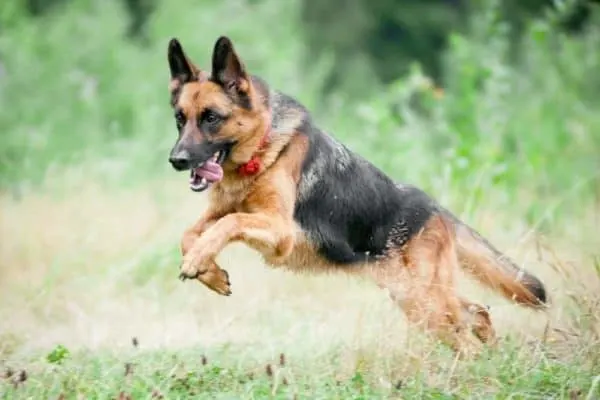
8. Sprints
German Shepherds are incredibly athletic dogs, with a lot of energy. They were originally bred as working dogs, and have a history of herding.
This means that sprinting exercises are excellent for them, as well as being a lot of fun and very mentally engaging.
Sprinting can significantly enhance their cardio fitness, as well as help build muscle and strength.
It is also a great way for them to use up their energy, and it is highly mentally stimulating for them, especially if the sprinting is turned into a game.
The best way to perform this exercise is by using a tennis ball launcher or similar. Something that will throw an object far away at a very high speed, for your dog to chase.
In order to catch it, your dog will have to sprint really fast.
Your dog will love this activity, and it’s pretty comfortable for you as you will be using a gadget to launch the object, and therefore you are using minimal energy, while your dog is being tired out.
The best surface to do this on is grass, or any other surface with good traction so that your dog does not slip and fall!
Exercise Routine:
You should perform this exercise around three to four times a week, allowing for breaks and rests in between sets of sprints.
You should avoid doing it during hot or humid days. Make sure your dog gets plenty of water afterward!
9. Weave Poles
As we’ve been mentioning, German Shepherds are highly athletic and incredibly agile. They are also highly intelligent and love completing exercises and training, as they were originally bred for working.
This means that weave poles are an excellent exercise that your German Shepherd will not only enjoy but excel at.
Weave poles can be really fun for your dog, and they will significantly enhance both speed and agility. They are also great for teaching focus, and for getting your dog to follow your lead instantly.
There are plenty of weave poles available in the market, and you can easily set some up in your garden, or take some with you to the park. The grass is the most ideal surface for this exercise.
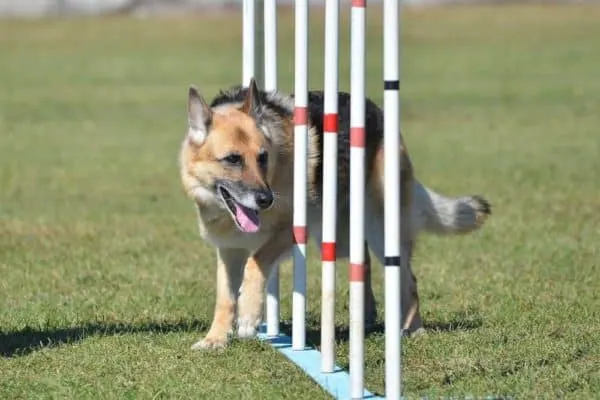
To perform this exercise, follow these steps:
- Set up the weave poles in your garden, yard, or similar. You can adjust the difficulty, starting off with wider spaces between the poles for the easiest level.
- Use treats to lure and guide your dog from one end of the poles to the other, by walking in zig-zag between them.
- Insert a command word, so that your dog knows it has to go through the weave poles, to the end, in order to get a treat.
- Slowly increase the speed. Eventually, you can stand at the other end, give the command, and your dog will perform the exercise.
- Start timing your dog and upping the difficulty. Reward always at the end, once your dog has made it through the weave pole.
If your German Shepherd ends up being really good at this exercise, you could maybe even end up in an agility competition, who knows!
Exercise Routine:
Practice this exercise two to three times a week, slowly increasing the difficulty and challenging your dog to get faster each time. Make sure to use plenty of treats!
Why should you exercise your German Shepherd?
Okay, so we’ve covered the top 9 best exercises for your German Shepherd. But why should you exercise your German Shepherd? Is it really that important?
Yes. It is. German Shepherds need a lot of exercise, and if they don’t get enough of it, they can develop some serious problems, both physical and behavioral.
In fact, here are some of the main negative consequences of not exercising your German Shepherd:
Health and Weight Problems:
- Lack of coordination and strength
- Joint problems
- Obesity and other weight problems
- Muscle atrophy
- Bone and spine degeneration
- Diabetes
Overall, these can lead to a huge amount of different health problems, injuries, and illnesses.
Behavior and Mental Problems:
- Separation anxiety
- Boredom (this can lead to barking, chewing, and other bad behavior)
- Easily excited and hyperactive behavior
- Toileting issues
- Inability to relax and settle down
Overall, these can lead to your dog having many behavioral problems. Your dog will be unable to maintain focus or attend training, plus your dog will be bored which leads to a myriad of other problems.
Not to mention that your dog will not be as happy as it could be.
How to Plan Your German Shepherd’s Exercise Routine:
When planning the exercise routine for your German Shepherd, there are a few different things you need to consider:
- Your dog’s age:
Depending on the age of your dog, you can perform certain different types of exercises, at different levels of intensity.
For example, puppies can’t perform the same exercises as adult German Shepherds, and the same goes for senior dogs.
Most exercise routines are designed for fully adult dogs.
- Your dog’s health:
Your dog’s health is something you always need to keep in mind and take into account.
If your dog has any health issues or injuries, you might not be able to perform certain types of exercise, or you might have to significantly reduce the intensity and difficulty.
- The types of exercises:
When putting together the exercise routine for your German Shepherd, make sure it combines a good variety of different types of exercises, and that they are placed the right way.
So for example, don’t have a high-intensity workout right after another high-intensity workout. It’s important that your dog gets enough rest in between!



















